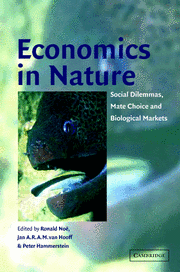Part III - Mating markets
Published online by Cambridge University Press: 04 August 2010
Summary
Mating usually involves a bilateral decision of two individuals to accept each other as partners. However, depending on the species and on socio-ecological circumstances, females can differ strongly from males in how choosy they are and what principles govern their choice. In many animal species females are far more choosy than males. Evolutionary explanations of this phenomenon are typically based on the idea that competition for access to mates is stronger in males than in females. This asymmetry seems to be induced by differences in reproductive potential and, ultimately, by differences between eggs and sperm (anisogamy). Now, whenever there is strong choosiness in one sex, it pays the other sex to advertise desired properties and hide the undesired ones. Assuming that different advertisements are indeed compared by potential mating partners, the success of an advertisement will depend on how one's own signal compares to that of the competitors.
This competitive situation creates a mating market where individuals have different market values because they differ in their signalling potential. The higher an individual's market value, the larger its scope for being choosy itself. Therefore, Pawl-owski and Dunbar study the heterosexual human mating market and explore how sensitive individuals are to their own market value. By analysing written advertisements they demonstrate a positive correlation between market value and aspiration level. They also show that, with an interesting exception, advertisers behave as if they know the choice criteria of the opposite sex. This is an important requirement for the mating scene to operate as a market.
- Type
- Chapter
- Information
- Economics in NatureSocial Dilemmas, Mate Choice and Biological Markets, pp. 185 - 186Publisher: Cambridge University PressPrint publication year: 2001

